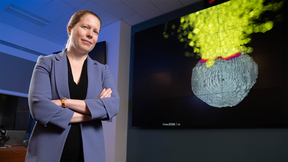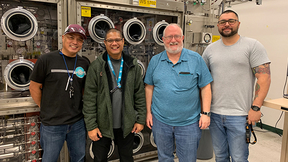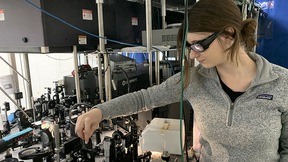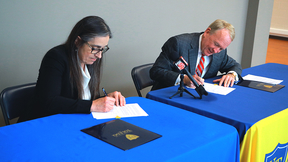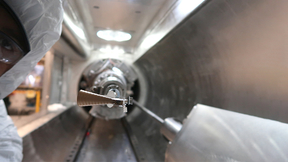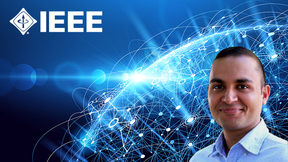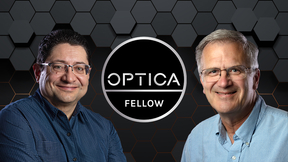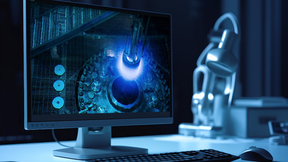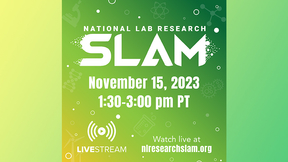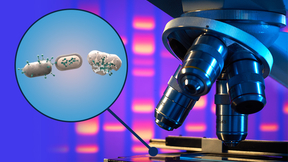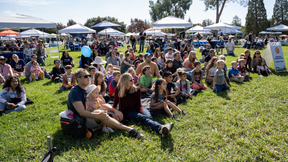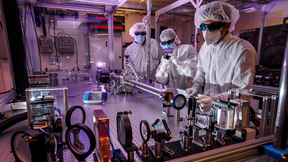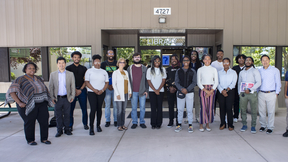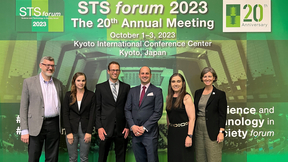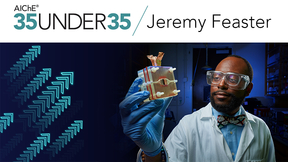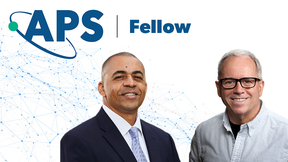Back
Science
New nuclear deflection simulations advance planetary defense against asteroid threats
Researchers at Lawrence Livermore National Laboratory (LLNL) have developed a modeling tool for assessing the potential use of a nuclear device to defend the planet against catastrophic asteroid impacts. The research, published today in the Planetary Science Journal, introduces a novel approach to simulating the energy deposition from a nuclear device on an asteroid's…
Engineering divisions provide expertise and support fusion energy’s future
In the 2000s, Lawrence Livermore National Laboratory (LLNL) engineer Steve Hunter was asked to work on the concept for an Inertial Fusion Energy (IFE) power plant, not because of any laser or electronics knowledge that he has, but due to his firearms expertise. He needed to figure out how to inject a stream of targets into the target chamber, so that a constant source of…
Watching aluminum’s reaction under extreme pressure
Understanding laser material interactions has applications that include inertial confinement fusion, material research and equation of state studies. Laser ablation, and specifically increasing the pressure that can be achieved from a laser system, is a longstanding topic of scientific research with implications ranging from damage in layered devices like solar cells and…
Lawrence Livermore National Laboratory and University of Toledo sign collaborative research agreement
Lawrence Livermore National Laboratory (LLNL) and The University of Toledo (UToledo) formalized a collaboration agreement with a signing ceremony on Wednesday, Nov. 8. The agreement calls for the institutions to exchange science and technology ideas, to support student opportunities and internships and to pursue research and development in areas like solar energy and other…
Probing the temperature of materials under extreme pressure
In new experiments at Lawrence Livermore National Laboratory’s National Ignition Facility, scientists measured the extended X-ray absorption fine structure (EXAFS) of copper to probe its temperature under extreme pressure. The research appears in the journal Nature Communications. Dynamic compression experiments at high-energy-density laser facilities have expanded the…
LLNL’s Kailkhura elevated to IEEE senior member
The Institute of Electrical and Electronics Engineers (IEEE), the world’s largest technical professional organization, has elevated Lawrence Livermore National Laboratory research staff member Bhavya Kailkhura to the grade of senior member within the organization. IEEE has more than 427,000 members in more than 190 countries, including engineers, scientists and allied…
Migration of elements found in nuclear waste may get a boost from natural proteins
Past and present nuclear activities (energy, research and weapon tests) have increased the need to understand the behavior of radioactive materials in the environment. Nuclear wastes containing actinides (such as plutonium, americium, curium and neptunium) are particularly problematic as they remain radioactive and toxic for thousands of years. However, when compared to…
Lab researchers Di Nicola and Wisoff elected Optica fellows
Jean-Michel “JM” Di Nicola and Peter “Jeff” Wisoff of Lawrence Livermore National Laboratory (LLNL) have been selected as fellows of Optica (formerly OSA). Fellows are selected based on several factors, including distinguished contributions to education, research, engineering, business and serving the optics and photonics community. Click here to see the entire Optica 2024…
PROSPECTing new perspective on reactor-produced neutrinos
While neutrinos are one of the most common particles in the universe, their elusive nature makes it challenging to understand their behavior. In new research from the Precision Reactor Oscillation and Spectrum (PROSPECT) Experiment, scientists have produced final results from measurements of neutrinos emitted by a nuclear reactor at the Oak Ridge National Laboratory. Their…
Save the date of the inaugural National Lab Research SLAM
Each of the 17 DOE laboratories will send one researcher to the National Lab Research SLAM, a hybrid event taking place on Capitol Hill and livestreamed across the country. Brandon Zimmerman will represent Lawrence Livermore National Laboratory, bringing his talk on “3D Printing the Future: Designing Additively Manufactured Materials for Extreme Environments” to Washington…
Rewetting of a seasonally dry California grassland soil helps microbe-preying viruses thrive
Beneath the Earth's surface, a relentless conflict unfolds as soil viruses prey on their tiny microbial hosts, fundamentally shaping our planet's ecosystems. New research from Lawrence Livermore National Laboratory (LLNL) scientists and their collaborators at the University of California, Berkeley illuminates a fascinating phenomenon: the demise of soil bacteria and other…
LLNL hosts thousands of enthusiastic explorers for Open House 2023
Nearly 19,000 employees and guests visited Lawrence Livermore National Laboratory’s Open House 2023 on Oct. 21 and 22: an unprecedented crowd witnessing the Lab’s innovative science and technology up close. With the theme of “Explore, Discover, Innovate,” every corner of the Lab — from the site of the world’s first fusion ignition reaction to the upcoming home of the world…
LLNL leads initiative to advance muon-based imaging
Today we can see inside seemingly impossible places — nuclear reactors, volcanoes, tsunamis, hurricanes and Egypt’s Great Pyramid of Giza — thanks to muon imaging. This technique uses naturally occurring subatomic particles called muons, which can penetrate far deeper than possible with X-rays through material as thick and dense as 30-meter concrete walls. But this process…
LLNL hosts HBCU students, faculty to build new pipeline of talent
For the second consecutive year, Lawrence Livermore National Laboratory (LLNL) hosted a group of student scholars and faculty members from Historically Black Colleges and Universities (HBCUs) on a recent five-day visit. LLNL’s goal is to develop the next wave of summer interns — and to build a strong pipeline of talent — from historically marginalized groups in science,…
Radiochemistry intern digs deep to prevent the spread of nuclear waste
The groundbreaking discoveries and scientific advancements that take place at Lawrence Livermore National Laboratory (LLNL) and across the broader national laboratory system rely on the passage of information from tenured staff scientists to new interns and early career scientists. This past summer, Zachary (Zach) Murphy, a Ph.D. student studying chemistry at the…
Young leaders learn from Nobel Laureates at Science and Technology in Society Forum
Early-career staff scientists Kelli Humbird, Chris Young and Brian Giera connected with Nobel Laureates and discussed important global issues ranging from AI to climate change at the 20th annual meeting of the Science and Technology in Society (STS) Forum in Kyoto, Japan. Lab Director Kim Budil, Acting Chief of Staff Ashley Bahney and Strategic Deterrence Associate…
‘STEM Day at the Lab’ returns: students engaged and inspired by STEM fields
Lawrence Livermore National Laboratory (LLNL) welcomed more than 145 students from the Bay Area (Oakland, Pittsburg and San Mateo) to ‘STEM Day at the Lab’ on Friday, Oct. 6. STEM Day is a biannual daylong interactive event focused on science, technology, engineering and mathematics (STEM) activities for students (grades 5-8) from underserved or disadvantaged communities…
LLNL’s Feaster named to American Institute for Chemical Engineering’s '35 Under 35' class for 2023
Lawrence Livermore National Laboratory staff scientist Jeremy Feaster has been named as one of the American Institute for Chemical Engineering’s (AIChE) “35 Under 35” award winners for 2023. The recognition honors chemical engineers under the age of 35 who have made outstanding contributions to their field and to the chemical engineering community, according to the…
Two LLNL scientists selected as 2023 American Physical Society fellows
Lawrence Livermore National Laboratory (LLNL) scientists Manyalibo “Ibo” Matthews and Frank Graziani have been named 2023 American Physical Society (APS) fellows. Matthews was selected from the Forum in Industrial and Applied Physics unit “for pioneering research in optimizing metal 3D printing and laser materials processing.” Frank Graziani was chosen from the Division of…
Journey to the center of the earth: exploring iron’s equation of state
A typical high-school science class teaches that Earth’s core is comprised of two parts: an inner core that is composed mainly of solid iron and an outer core that is composed mainly of molten, liquid iron. Although this is common knowledge, the location of the boundary between the solid inner core and liquid outer core, as well as many other facets of Earth’s deep…


